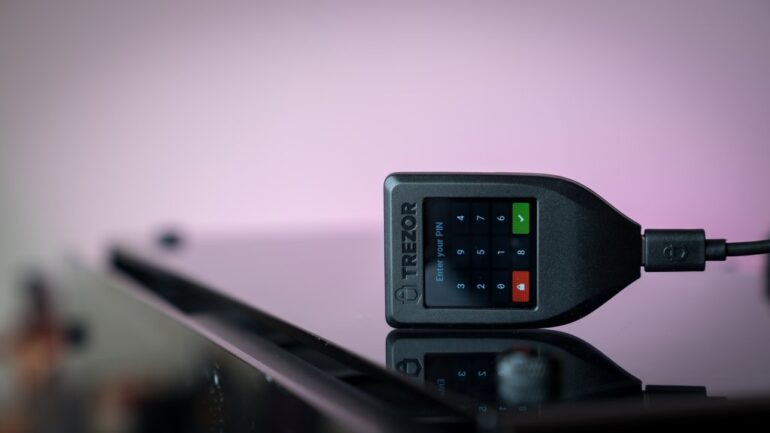The blockchain is a distributed ledger of computer code that enables transactions within a few clicks. An overwhelming majority of cryptocurrency wallets running on Internet-connected computers are available today.
It raises the question, “How does one safeguard this software?” With the ever-growing cyber crimes, the wallet program, the host computer’s OS, and the hardware running the OS are all susceptible to cyber attacks.
Specialized safe hardware serves fewer functions, which narrows its “attack surface” and hence is less vulnerable to malicious hackers constantly trying to find a method to undermine its security.
Trezor Model T

Digital software can only be trusted if it is developed without security breaches, is installed on an OS set to limit the risk of cyberattacks, and both the OS and the app are upgraded to resolve new security bugs. In consideration of these dangers, hardware wallets are becoming popular.
Satoshi Labs created the open-source, fully auditable digital Wallet branded the Trezor Model T.
It is a cutting-edge hardware wallet that considers the learnings from the original TREZOR while also including an updated, user-friendly design. Trezor Model T vs Trezor One comparison reveals Trezor T consists of a touchscreen, a powerful processor, and enhanced coin compatibility with all the functionalities of the TREZOR One.
Advantages Of Trezor Model T
- It is a trustworthy and widely used hardware wallet. No matter your level of expertise in cybersecurity, it provides top-tier protection for your cryptocurrency holdings, passwords, and Second Factor authentication while being incredibly simple to use.
- Many safety mechanisms are pre-installed in this unit. It is designed to prevent loss or theft due to digital attacks launched by hackers and malware. It safeguards your cryptographic private keys and never divulges them to any other parties.
- Your unit’s software sends a raw transaction to your Trezor Model T and asks it to sign it when you make a transaction. The user must sign any crypto expenditure transaction with the private key corresponding to the blockchain address holding the crypto before it can be broadcast to the blockchain network.
- Upon receiving a raw transaction, you will be alerted of a possibility of a stolen wallet. The user can verify the transaction’s total, correct address, and charge before committing to the trade with a digital signature. It prevents malicious software from spoofing the recipient’s address or conducting fraudulent financial dealings.
- The device’s seal should be checked to ensure it is still functional. A holographic sticker protects the USB port on your digital Wallet upon arrival. The hologram needs to be positioned directly above the device’s USB-C interface.

This holographic strip provides a very reliable seal because it is ultrasonically bonded to the fasteners. The hologram strip must be removed before the gadget may be used, leaving a visible mark on the apparatus. Effects on the device indicate that it has been removed. A malicious party cannot alter the hardware of this unit and then resale it to an unwary customer, thanks to this straightforward security measure.
Installing And Setting Up Trezor Model T
- The hardware contains a USB-C cable and additional accessories. It also consists of two recovery seed cards, and a Getting started guide. The black plastic behind the hardware also serves as a magnetic dock for your new electronic device. Stick it to any hard surface with the included 3M double-sided tape. Mount it on your Model T to see the display.
- The device is fully functional across all popular platforms. The latest versions of Chrome and Firefox work well with the device and Wallet. Following the successful connection of your device, a brief security check will be initiated. In about a minute, your gadget will restart with the updated software. It begins the initialization process. Trezor Suite will prompt you to sync your device.
- Furthermore, you can choose whether or not to engage in anonymous collecting data. It does assist us with problem repairs and efficiency enhancements, so we encourage permitting it.
- Follow the on-screen prompts and the instructions included with your Model T to get started and install the firmware. Once installed correctly, the Wallet will prompt you to select between creating a new wallet or recovering an existing one.
- Once the device has finished processing your request to create a new wallet, a new interface will be presented to you. While you’re welcome to delve into the Wallet at your leisure, sending any funds to the Model T requires completing the onboarding process.
- Follow the on-screen instructions in the Wallet to generate a recovery seed for your Wallet and store it safely. An individual 12-word recovery seed is generated by the Model T and displayed on the screen. To verify your identity, it will randomly choose two words and have you retype them on the display unit. If you enter the words wrong, the device will show you all 12 words again to make sure.
- While installing the software, do not turn off your smartphone. Any interruption will make you lose access to your recovery seed forever, resulting in starting the procedure from square one.
- Finally, name your TREZOR and pick a personal identification number that is entirely different from any others. Put in at least four distinct digits. It has a simple mechanism. You’ll need to enter your PIN code every time you do a transaction. It is a 4-digit number between 1 and 9. It provides you with 16 chances. After 16 unsuccessful PIN attempts, it prevents brute force assaults. Due to the limited hacking chances, it is difficult to carry out transactions even if a hacker gets access to your vault.
Bottomline

Manufacturers of hardware wallets integrate security safeguards to guarantee that your private keys are never exposed to the outside world.
Your private keys will always be secure in specialized offline hardware, regardless of what new software flaws are uncovered. The zero-trust philosophy underpinning the Trezor Model T is what makes this an incredible choice. It implies that the Trezor Model T does not automatically trust Trezor Wallet or any other external wallet service; instead, it verifies it.
